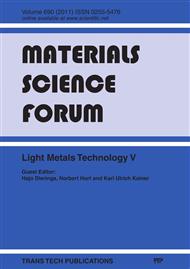p.306
p.311
p.315
p.319
p.323
p.327
p.331
p.335
p.339
Strain Rate Effects on the Flow Behaviour and Microstructure of ECAPed Magnesium-Alloys
Abstract:
Three alloys of the magnesium AZ-series (AZ31, AZ61 and AZ91) were processed by multi-temperature equal channel angular pressing (ECAP) with five passes using route BC. The ECAP temperature was decreased from 275 °C to 250 °C during the process for better grain refinement. The mechanical behaviour was investigated over a wide range of strain rates (10-3 s-1 up to 103 s-1) under compressive loading at room temperature. The investigations show that significant grain refinement takes place during the ECAP-process. The initial grain size of 12 μm, 9 μm and 5.8 μm for extruded AZ31, AZ61 and AZ91, respectively, could be refined to 2.5 μm. The grain refinement occurs by dynamic recrystallisation. Compared to extruded initial Mg-alloys, the yield stress increases slightly for all selected alloys after ECAP processing, while the amount of strain hardening decreases at the same time, due to reduced grain size and texture effects. Furthermore, the flow stress of extruded and ECAPed material is less affected by strain rates within a range of 10-3 s-1 to 10-1 s-1.
Info:
Periodical:
Pages:
323-326
Citation:
Online since:
June 2011
Authors:
Price:
Сopyright:
© 2011 Trans Tech Publications Ltd. All Rights Reserved
Share:
Citation:


